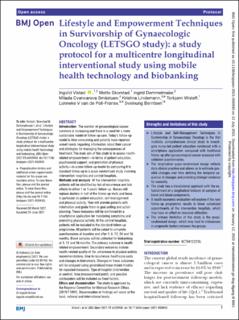| dc.contributor.author | Vistad, Ingvild | |
| dc.contributor.author | Skorstad, Mette | |
| dc.contributor.author | Demmelmaier, Ingrid | |
| dc.contributor.author | Småstuen, Milada Cvancarova | |
| dc.contributor.author | Lindemann, Kristina Yvonne Kathe | |
| dc.contributor.author | Wisløff, Torbjørn | |
| dc.contributor.author | Van De Poll-Franse, Lonneke V | |
| dc.contributor.author | Berntsen, Sveinung | |
| dc.date.accessioned | 2022-02-22T14:52:25Z | |
| dc.date.available | 2022-02-22T14:52:25Z | |
| dc.date.created | 2022-01-11T21:44:38Z | |
| dc.date.issued | 2021-07-12 | |
| dc.identifier.citation | BMJ Open. 2021, 11 (7), . | en_US |
| dc.identifier.issn | 2044-6055 | |
| dc.identifier.uri | https://hdl.handle.net/11250/2980829 | |
| dc.description.abstract | Introduction: The number of gynaecological cancer survivors is increasing and there is a need for a more sustainable model of follow-up care. Today’s follow-up model is time-consuming and patients have reported unmet needs regarding information about their cancer and strategies for managing the consequences of treatment. The main aim of this study is to assess health-related empowerment—in terms of patient education, psychosocial support, and promotion of physical activity—in a new follow-up model by comparing it to standard follow-up in a quasi-randomised study involving intervention hospitals and control hospitals.
Methods and analysis: At the intervention hospitals, patients will be stratified by risk of recurrence and late effects to either 1 or 3 years’ follow-up. Nurses will replace doctors in half of the follow-up visits and focus in particular on patient education, self-management and physical activity. They will provide patients with information and guide them in goal setting and action planning. These measures will be reinforced by a smartphone application for monitoring symptoms and promoting physical activity. At the control hospitals, patients will be included in the standard follow-up programme. All patients will be asked to complete questionnaires at baseline and after 3, 6, 12, 24 and 36 months. Blood samples will be collected for biobanking at 3, 12 and 36 months. The primary outcome is health-related empowerment. Secondary outcomes include health-related quality of life, adherence to physical activity recommendations, time to recurrence, healthcare costs and changes in biomarkers. Changes in these outcomes will be analysed using generalised linear mixed models for repeated measures. Type of hospital (intervention or control), time (measurement point), and possible confounders will be included as fixed factors. | en_US |
| dc.description.sponsorship | The study is funded by the Norwegian Cancer Society (198057), the UNI Foundation (6845) and the South-Eastern Norway Regional Health Authorities (2019073). | en_US |
| dc.language.iso | eng | en_US |
| dc.publisher | BMJ Publishing Group | en_US |
| dc.relation.ispartofseries | BMJ Open;Volume 11, Issue 7 | |
| dc.rights | Navngivelse-Ikkekommersiell 4.0 Internasjonal | * |
| dc.rights.uri | http://creativecommons.org/licenses/by-nc/4.0/deed.no | * |
| dc.subject | Gynaecological cancer | en_US |
| dc.subject | Cancer treatment | en_US |
| dc.subject | Follow-up care | en_US |
| dc.subject | Health-related empowerment | en_US |
| dc.subject | Consequences | en_US |
| dc.title | Lifestyle and Empowerment Techniques in Survivorship of Gynaecologic Oncology (LETSGO study): A study protocol for a multicentre longitudinal interventional study using mobile health technology and biobanking | en_US |
| dc.type | Peer reviewed | en_US |
| dc.type | Journal article | en_US |
| dc.description.version | publishedVersion | en_US |
| dc.rights.holder | © Author(s) (or their employer(s)) 2021 | en_US |
| dc.source.articlenumber | e050930 | en_US |
| cristin.ispublished | true | |
| cristin.fulltext | original | |
| cristin.qualitycode | 1 | |
| dc.identifier.doi | http://dx.doi.org/10.1136/bmjopen-2021-050930 | |
| dc.identifier.cristin | 1978923 | |
| dc.source.journal | BMJ Open | en_US |
| dc.source.volume | 11 | en_US |
| dc.source.issue | 7 | en_US |
| dc.source.pagenumber | 1-10 | en_US |
| dc.relation.project | Den Norske Kreftforening: 198057 | en_US |
| dc.relation.project | Stiftelsen UNI: 6845 | en_US |
| dc.relation.project | Helse Sørøst: 2019073 | en_US |

